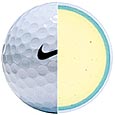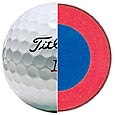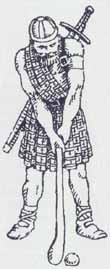Golf Ball reviews, have revealed some startling facts !!


Recent golf ball reviews have revealed that all is not as it seems, with the latest golf ball.
Golf balls have come a long way from the initial feathery ball, but are they, the key to distance and accuracy?
To determine this point, we have to travel back in time and see how the original golf balls were formed.
A Little History First
The original golf balls as most of us know, were made from goose feathers stuffed into a round leather ball. It is estimated that those could be hit as far as 170 yards with the modern club.

The next technological advance was the gutta percha ball. This was made from tree sap or rubber and compressed into a round mould. A modern club can hit these golf balls about 200 yards on average.
The Haskell method was to improve the ball construction, by having a soft core, and winding thin rubber around this core. This ball can be hit around the 225 to 250 yard range.
Further advances saw the introduction of a liquid core with a soft balata cover. However the ball became misshapen after several hits on it. It is rumoured that the great Ben Hogan passed his golf balls through a metal ring to check for roundness.
The modern golf ball has taken several leaps forward from those days. This golf ball mainly made with a surlyn or a urethane cover, which offers the same feel as a balata covered ball, Surlyn® is a synthetic, highly resilient, durable material that is used in the majority of golf balls in the industry. This material provides for a golf ball that will stand up to the durability test that the avid golfer demands, while allowing many different options for spin & distance combinations. Urethane is an extra-soft, synthetic material that provides high-spin performance and greater durability than balata. In fact, urethane is softer than both Surlyn® and balata. Could last for many rounds of golf, assuming that you did not lose the golf ball first.
The core is formed with a mixture of polybutediene and other compounds to give this soft core. Over the past four years, golf ball technology has evolved from a primarily wound-ball construction to the solid core/two piece construction to the double-core/four piece construction.
The distances achieved with this ball can be in excess of 300 yards.
But Is That all There Is To this golf ball comparison?
No, there are still a few more key points to understand, like dimples, the affect of spin, compression, storage conditions, and the rules that govern golf ball construction.
Dimples
How do dimple patterns affect the flight/trajectory of a golf ball?
Dimples provide the lift needed to get a ball airborne. Without them a golf ball's performance would be severely restricted. Golf balls come in a variety of different dimple patterns.
Some promote a higher flight trajectory that many golfers need, while others promote a lower, more piercing trajectory. In general though, balls with deeper dimples will tend to have a lower trajectory.
Deeper dimples create more turbulence in the boundary layer, which makes it more difficult for air to flow over the ball creating less lift. Those with shallower dimples typically will generate a higher trajectory.
Dimple pattern - the dimple pattern on a golf ball does not affect the spin, it creates the aerodynamic lift that allows a spinning ball to remain in the air longer.
Varying the dimple size also affects the aerodynamics of a ball. By matching the dimple pattern and the construction of a ball, manufacturers can optimise the resulting trajectory for both distance and control.
It is the combination of the lift and drag properties of the ball, as well as its speed, launch angle and spin rate, which will dictate the flight path or trajectory of the ball, and thus the distance it will go.
A perfectly smooth golf ball with no dimples would travel about 130 yards when hit with a driver by a good player. On the other hand, a ball with well-designed dimples, struck the same way, will travel about 290 yards.
Dimple design has changed significantly over time, from random patterns, to formal rows, to interstitial designs. The depth, shape and number have all been varied and tested.
Spin Rate

A golf ball's spin rate refers to the speed it spins on an axis while in flight, measured in revolutions per minute (rpm).
Spin rate off a driver generally ranges between 2,000 and 4,000 rpm, while the average, cleanly struck wedge shot spins at about 10,000 rpm.
Spin generates lift, thus a shot's spin rate directly influences how high the ball flies and how quickly it stops after landing. Beyond the manufacturer’s hype, there are real differences in ball construction affecting driving distance, approach control, putting roll, balance and cost.
Modern balls are made to very high standards of consistency and quality.
In driver shots, an excessive amount of spin will cause the ball to soar, resulting in a loss of distance. Too little spin will prevent lift and reduce carry.
Keeping the amount of spin at an appropriate level and hitting shots that trace ideal parabolic paths are the formula for maximizing distance.
The manufacturer can affect the spin rate with a variety of methods. The main way appears to be by having a larger softer core, which in turn provides more spin less distance.
Another method is to have the soft core encased in a mantle cover. This cover can be harder and thicker.
The more flexible this cover the more spin.
Understanding Compression
Compression is probably the most misunderstood description of a golf ball.
Many golfers have a misconception of what compression is and what it really means. In the early days of golf the term compression was used to describe the quality of a ball.
It determined the tightness of the windings around a 3-piece balls' core. The tighter the windings were the better the ball's performance. It became a common belief that a ball's workability and distance were a clear consequence of its compression.
Compression of a golf ball gradually became more of feel thing In the end the constant high quality of 2-piece balls made compression as a quality index obsolete Today the term compression is used in combination with a number ranging from 0 to 200. This figure tells us by how much a golf ball is deformed under a compressive force.
Although this term is now becoming obsolete it is still important to understand the importance of compression with regards to a golfer’s swing.
As golf balls are mass produced, all 3-piece balls and some 2-piece balls are measured by their compression and rated accordingly.
In order to do so balls are pressured with a standard weight. A ball, which does not deform is rated Compression 200, a ball that lets itself be deformed by 2/10 of an inch or more is rated Compression 0.
In-between these two extremes compression increases or decreases with every 1/1000 of inch of deformation. Standard Compression rate of a golf ball is 90 or 100. The lower the Compression rate the softer the feel.
Most balls are subject to a rating by compression Surveys have shown that low speed swing players should use a ball with a Compression rate of 80.
Average speed swing players should use Compression 100 and high speed swing players Compression 110.
However, new golf balls do not have an actual number, and prefer to say low spin rate or long distance. So read the label as they say.
Storage Conditions
How long can a golf ball last under normal storage conditions? Under normal storage conditions (70-80 degrees Fahrenheit) a golf ball can last forever.
However, it must be understood that certain factors can affect a ball’s overall performance.
Golf balls can lose their performance characteristics in cases of extreme heat or cold, and their construction is such that even under normal storage conditions, there can be a loss of performance over time.
Generally, a solid golf ball can experience a substantially longer shelf life than a wound golf ball without evidencing performance loss, however, both are susceptible to performance loss over extended periods of time.
Rules For Production Of Golf Balls
The Defined Diameter
According to the “Rules of Golf” the golf ball's diameter must be at least 1.680 inches / 42.67 mm. A smaller ball would tend to fly further than a big one. The reason is simple: having a smaller diameter the ball produces less air resistance or, differently put, does not need to displace as much air to continue it's flight. Hence the majority of the manufacturers produce golf balls with the minimal diameter of 1.680 inches / 42.67 mm.
The Defined Weight
The golf ball's weight must not exceed 1.620 oz./ 45.93 g. The heavier the ball the less it can be slowed down by air resistance, and therefore the further it would tend to fly. Hence the majority of the manufacturers produce golf balls with the maximum allowed weight of 1.620 oz./ 45.93 g.
The Defined Velocity The balls initial velocity cannot be greater than 250 feet per second
The Defined Distance The golf ball can not go on an average, further than 280 yards carry and roll.
But what does the golf ball review reveal?
Well, the golf ball review discovered that there are of course many factors, which have a direct impact on increased driving distance over the past 2 decades.
Such factors as fitness, materials, courses, and technique, have helped increase the driving distance over the years.
Why do the professionals hit the Golf ball in 2006 further then 1980?
Maxfli and PGA produced a golf ball review in 2002 to reveal the following:-
If the most important elements are compared, we find that improvement has occurred on all Points
(1st digit 1980, 2nd digit 2002):
swing speed=110mph/114mph;
ball velocity=158mph/165mph;
launch angle=7,5deg/9,0deg;
spin=3600rpm/2900rpm.
The average Driving Distance of the Professionals climbed from 256,9yds (1980) to 279.4yds (2002). Courtesy of Maxfli/PGA tour Information.
Since this time, other manufacturers have also carried our golf ball reviews for their own statistics. Not all have rvealed their findings, suffice to say that every manufacturer has developed a golf ball which has specific characteristic built in, whether it is distance, spin or mixture of both.
The manufacturer is able to do, as they want to the ball. The Trend is going to a balance between spin (rpm) and higher launch angle and hence more distance.
Further golf ball reviews and tests were carried out by Nick Faldo using a modern golf driver, on a gutta percha ball, and the ball did not travel more than 150 yards.
When he used an old wooden golf club, and a modern golf ball, the ball travelled more than 260 yards.
This showed that the modern golf ball is definitely the key to distance.
Conclusion
\\\\\\\\\\\\\\\\\\\\\\\\\\\\\\\\the golf ball reviews have shown that golf balls are distance balls constructed to stop quickly on the green, with less of the risk of slice or hook into trouble that a pure spin ball brings.
Recent advances in construction technology are spawning a new breed of balls that can do it all, such as the Titleist ProV1, and Callaway Hex.
SLOW SWING (often called Ladies or Senior) balls are designed to optimise driving distance for less powerful players with slower club head speeds.
Most balls are imperfectly balanced and thus do not putt completely true. Premium quality balls may be manufactured to higher quality control standards and thus less likely to randomly wander off track.
Try to find out which modern affordable golf ball meets your style of play.
It is better to play consistently with a ball you can afford than to play competitions with a premium ball that you cannot afford to practice with.
Balls with cuts or used until no longer spherical add nothing to your game. Better to play an affordable ball and replace it regularly.
Further Reading on Golf Ball Technology
All golf balls look the same, but do they perform the same?
New and Used Golf Balls Links
Buy Golf balls|Used Golf balls|Range balls
World wide supplier of quality used golf balls. Extensive experience in international shipping 16 years plus. Online shopping cart, portal to our e-bay golf ball/apparel auctions plus more.
Used Golf Balls - Cheap custom logo golf balls
Cheap used golf balls & custom logo golf ball at wholesale prices. Used golf balls from the top golf ball companies: Titleist, Callaway, Top Flite and others. Discount golf balls available for order.
Return to Top of Golf Ball Reviews Page Return to Home Page